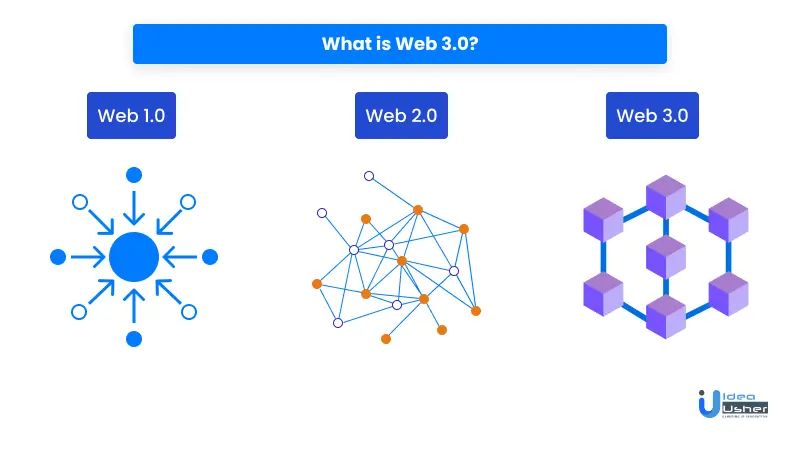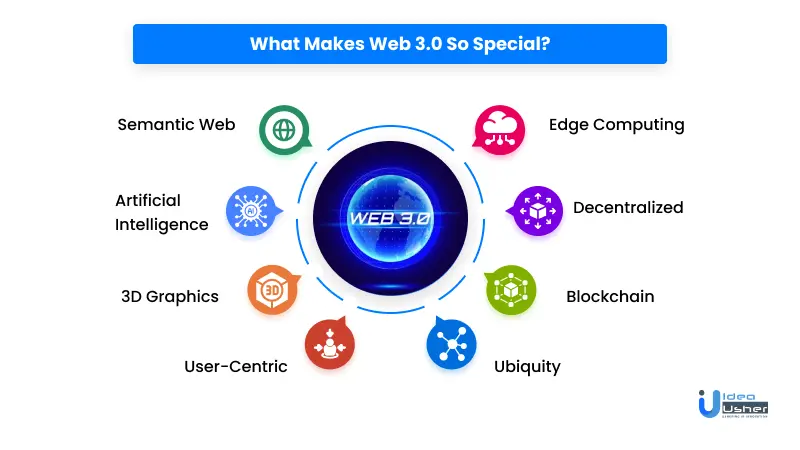The Web 3.0 blockchain revolution is about to change how business is done.
The Web 2.0 revolution has changed how we communicate and share information, but it hasn’t yet affected how we do business. But that’s about to change as we enter into a new era of computing: Web 3.0
It is more than just another upgrade on an existing technology platform. Web 3.0 is a paradigm shift in how people use computers and interact with each other online. It’s comparable to how mobile phones changed how people communicated when they were introduced
20 years ago. It will be much bigger this time because of its impact on enterprises, not just consumers!
What is Web 3.0?

Web 3.0 is a term that describes the current and future state of the web.
It refers to the next generation of internet-based applications, including peer-to-peer (P2P) networks and distributed applications.
There have been three generations of the web. These are as described below.
- Web 1.0 (1991-2000): The first wave of the internet was all about hyperlinks, websites, and information. It was largely text-based, with no multimedia or rich media content.
- Web 2.0 (2000-2010): This era shifted from static websites to interactive ones. These allowed users to create content online through blogs, social media sites, and even video-sharing sites like YouTube. It encouraged users to participate actively in their online experience. They created and shared content — making this era all about user-generated content (UGC).
- Web 3.0 (2010-present): We’re now seeing a shift toward artificial intelligence, machine learning, blockchain technology, and virtual reality (VR). As these technologies become more mainstream, they’ll change how we interact with information on the web.
Web 3.0 is the next evolution of the internet. Here, decentralized applications (DApps) are built on a peer-to-peer network of nodes. Instead of controlling our data and information, we can securely store it on a blockchain and share it with others when needed.
Key Market Takeaways for Web 3.0
The Web 3.0 blockchain market is projected to experience significant growth, with a market size valued at USD 1.89 billion in 2021. By 2030, the market is expected to reach an impressive USD 52.89 billion, reflecting a compound annual growth rate (CAGR) of 44.8% over the forecast period (2022-2030).
What Makes Web 3.0 So Special?

Web 3.0 is an evolution beyond today’s Web 2.0, defined by social media and mobile devices. The third-generation internet will be built around decentralization and disintermediation. In this, no single entity controls all the data shared between users or on their own devices.
As technologists continue to develop new ways for us to interact with each other online, Web 3.0 will give us greater control over our digital identities and how we share information about ourselves online. In addition, it will allow us to exchange values easily with each other without relying on centralized authorities like banks or governments to facilitate transactions between parties.
Here are the components of Web 3.0 that make it unique and revolutionary for businesses.
1. Semantic Web
The Semantic Web aims to make data and information on the web easier to access, share, and reuse. It is a vision of the future where machines understand the meaning of human language (natural language). In addition, human beings can find, access, and integrate information more effectively.
It builds on concepts developed in Artificial Intelligence (AI), especially Knowledge Representation (KR), Natural Language Processing (NLP), and Machine Learning (ML). The web also builds on prior work in data integration, modeling, databases, and information retrieval.
Semantic Web technologies include RDF, RDFS, OWL, SPARQL, DAML+OIL, SKOS, and SWRL.
2. Artificial Intelligence
The most talked about component of Web 3.0 is artificial intelligence (AI). AI is all around us today, from Siri on your iPhone to Alexa in your home. But AI can do much more than just answer questions and play music. It can also learn from its experiences, make decisions, and solve problems independently.
Many experts believe that AI will be one of the most important technologies in our lives because it will change how we learn, work, and live as humans.
3. 3D Graphics
Another important aspect of Web 3.0 is 3D graphics. The ability to display three-dimensional objects on a computer screen makes it possible for people to view images in full color and with realistic detail. This technology is changing how people interact with computers. It allows them to manipulate virtual objects on the screen as if they were real things that could be touched or moved around at will. The most significant aspect of this technology is its ability to allow people to move around freely in an environment that feels like it has depth and substance.
4. User-Centric
The concept of user-centricity is a common thread throughout Web 3.0. It’s one of the defining characteristics of the entire concept. The idea behind this is that websites should be designed around the needs and wants of their users rather than trying to sell them something or get them to buy something.
5. Ubiquity
Ubiquitous computing is the ultimate goal of Web 3.0. It is a term that describes devices and services accessible anywhere, anytime, and from any device (e.g., mobile phones and PDAs). Ubiquitous computing allows users to be connected all the time. Every device can access information from anywhere in the world and vice versa.
6. Blockchain
The blockchain is the core technology of Web 3.0. A decentralized ledger allows people to exchange digital assets without needing a central authority to verify those transactions.
Blockchain can be used for anything from tracking products to recording land ownership, but its most famous use is as an alternative currency system. Bitcoin and other cryptocurrencies like Ethereum are built on blockchain technology, allowing people to send money worldwide without going through a bank or government.
7. Decentralized
Web 3.0 is decentralized. Users control their data, and no third party can hold the network. The web is designed to be censorship-proof and tamper-proof. No one can halt your communications or tamper with the content you post online.
In contrast, today’s Web 2.0 is centralized, meaning that most of our data live on servers owned by companies like Facebook and Google. These companies can restrict access to information, censor content, or even shut down an entire network (like when China blocked WhatsApp).
8. Edge Computing
Edge computing is a computing paradigm that focuses on using data at the edge of a network, close to the data sources. This means the data doesn’t have to be sent to a central server before processing. It can be processed locally and then sent once it’s ready.
Edge computing is also referred to as fog computing or cloudlet computing. The key difference between edge computing and its predecessors is that it’s more distributed than centralized. In other words, it relies less on centralized servers such as those found in data centers or cloud services than on local devices like smartphones, sensors, wearables, etc.
Why Should You be Paying Attention to Web 3.0 Blockchain?
Now that we have gone over the details of Web 3.0, the question arises: how will it affect your business? Here are five reasons you should pay attention to the Web 3.0 blockchain.
1) A new layer of trust
Blockchain technology establishes a new layer of trust by providing transparency and accountability across an entire network. It allows users to view all transactions in real-time and can’t be altered once others confirm on the web. This means anyone can see how the network operates without permission or authority from any single entity.
2) Security and privacy
Blockchain offers a secure platform for storing data, making it virtually impossible for hackers to access sensitive information like credit card numbers or passwords. Since it’s decentralized, all the data is stored on different computers worldwide, so there is no central point of failure — meaning there is no single point where hackers can attack and steal information.
3) New ways of monetizing content creation
When you create great content, you want people to see it — and for them to keep coming back. You also want to make sure that you’re compensated for your work. With Web 3.0 blockchain technology, creators can develop their platforms to sell their work directly to their customers without going through third-party platforms like Facebook or YouTube.
4) Data Ownership
Blockchain is an immutable and decentralized ledger that records transactions between two parties efficiently and in a verifiable and permanent way. This means that data is always accessible by authorized parties, and no one can tamper with or delete it without being detected by others.
This means that businesses can now offer their customers real ownership over their data by allowing them to monetize it through sharing or selling their information directly with other companies or individuals instead of having their data stored on centralized servers owned by corporations like Facebook or Google, which have been accused in recent years of misusing personal data for marketing purposes or even selling them off to third parties without users knowing about this practice.
5) Better user experience
The biggest advantage of Web 3.0 is that it offers a better experience for users. For example, with the help of blockchain technology, users can create decentralized websites that run on their servers. This means they don’t need any third-party applications or services to host their websites – they just need to access a browser and connect to a server where they can access their site.
In addition, because all websites are decentralized, no restrictions or rules are imposed on them by any company or organization. This gives users more freedom to create whatever kind of content they want without worrying about censorship or limits being imposed on them by anyone else.
How Does Web 3.0 Blockchain Impact Various Businesses?
Blockchain can disrupt many industries, from finance and health care to government and real estate. Here are some ways in which blockchain makes an impact:
1. Financial Services
The most obvious place where blockchain will make an impact is in finance. Bitcoin was the first major application of this technology, but it’s not the only one. Hundreds of startups are working on new ways to use blockchain to improve financial services operations.
2. Health Care and Medicine
The healthcare industry is another area where blockchain could prove revolutionary. In addition to allowing patients more control over their medical records, blockchain could also help doctors share information about treatments more securely, thereby improving patient outcomes. Additionally, blockchain could help improve pharmaceutical access by allowing patients easier access to drugs from other countries at lower prices than those available in their own country.
3. Real Estate
Blockchain can make all real estate transactions more efficient and less expensive by eliminating third parties, simplifying transaction documentation and record-keeping, increasing transparency in title search processes and auditing documents, reducing fraud risks, and making payments more secure. With smart contracts, buyers and sellers can transact directly without relying on a title company or escrow agent to facilitate settlement.
4. Insurance
It’s no secret that the insurance industry is ripe for disruption — and the blockchain could help make that happen. The technology could allow insurance companies to verify claims more easily, streamline processes, and reduce fraud by providing immutable records of all transactions on a public ledger that anyone can see.
5. Logistics
Logistics companies also stand to gain from blockchain adoption since they operate in such a heavily regulated environment that relies heavily on paper records handled manually by people who may have limited training or expertise in data management. Blockchain offers an alternative way for these organizations to track shipments and maintain records securely without relying on someone else’s systems.
Develop Your Web 3.0 DApp
The technology has been used in various industries to disrupt traditional business models, and there are many more uses for this technology that we have yet to discover. Here are five ways you can use blockchain in your business:
1. Create a decentralized identity management system. You can use blockchain to create a decentralized identity management system that gives users complete control over their personal information and how third parties use it.
2. Build an immutable audit trail for all transactions on your platform or marketplace. This will help build trust among buyers and sellers who want to know that their transactions are safe from tampering or fraud at any point while making a sale or purchase through your platform or marketplace.
3. Create an immutable record of product information, such as ingredients and nutritional facts, so consumers have easy access to this information when they make purchases online or offline at retail stores where products are sold
4. Blockchain can create smart contracts between two parties that must be fulfilled before the transaction is completed.
5. Blockchain can also be used for identity verification by allowing users to create an ID wallet where their personal information is stored securely on their device, only accessible through biometrics or passcode protection.
6. Another one of the most common uses of this technology is in DApps or Decentralized Apps. These applications use blockchain as their main platform and run on their protocol instead of being hosted by a single company or organization.
If you’d like to learn more about blockchain, check out our guide on how blockchain technology and DApps work.
Idea Usher can help you develop a DApp (decentralized application) for your business with our expert team of developers and designers who know how to make it work seamlessly with your website or app.
We have created many successful applications using various blockchains, including Ethereum, Stellar & Hyperledger Sawtooth (IBM). Connect with us to learn more about the development process and options.
Conclusion
Web 3.0, powered by blockchain technology, presents a paradigm shift for businesses. The decentralized nature of Web 3.0 empowers users with data ownership, fosters transparency, and offers enhanced security. Businesses that embrace this transformation can unlock new revenue streams, build trust with customers, and operate more efficiently. While Web 3.0 is still evolving, it holds immense potential to reshape the business landscape. By understanding its core principles and staying adaptable, businesses can position themselves to thrive in the decentralized future.
Work with Ex-MAANG developers to build next-gen apps schedule your consultation now
FAQs
Q. How does blockchain affect businesses?
Blockchain has received enormous attention from big businesses and the general public in the past few years. The technology offers a new way to record transactions and share information among different parties. This technology is believed to revolutionize many industries, such as finance, real estate, supply chain management, health care, etc.
Q. What problems will Web 3.0 solve?
Web 3.0 will give users more control over their data and how they share it with others. It will also prevent companies from spying on you or selling your information to advertisers. The new web will be decentralized, so there won’t be a single point of failure that could take down the entire network.
Q. Are there any problems related to Web 3.0 technology?
One of the issues with Web 3.0 technology is that it requires a lot of storage space on your computer or device to run smoothly. This can cause problems for many people who do not have unlimited data plans or who live in areas where internet speeds are slow or nonexistent.
Q. Which companies use Web 3.0?
This trend toward greater interactivity has already begun with social networking sites like Facebook, Twitter, LinkedIn, and Google.





















